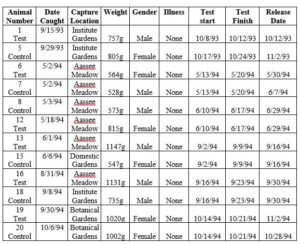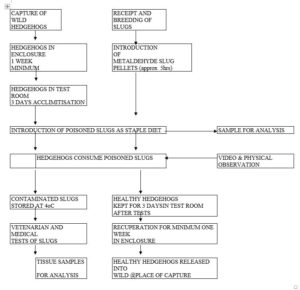Gemmeke (1995) hedgehog metaldehyde pesticides secondary poisoning slugs
Translation of:
Investigation of the hazard of secondary poisoning of hedgehogs (Erinaceous europeaeus L.) by metaldehyde ingested by slugs on arable land.
Summary:
The use of pellets containing metaldehyde to control slug populations on arable land involves the possibility that hedgehogs may come into contact with poisoned slugs or with pellets directly. The aim of this study is to determine whether hedgehogs kept in an enclosure feed on slugs treated with metaldehyde, and if so, display any signs of poisoning. Of the six hedgehogs used one consumed none, and one twelve of the slugs. The other four ate all or nearly all of the 200 treated slugs. Neither symptoms of metaldehyde poisoning nor behavioural disorders were detected in any of the hedgehogs. All hedgehogs survived the study without negative effects and were released back into the wild in a good state of health to the place from where they were originally captured.
The results demonstrate the following:
- some hedgehogs eat dead slugs either reluctantly or not at all.
- some hedgehogs eat metaldehyde-treated slugs in large numbers
- -healthy adult hedgehogs can consume up to 200 treated slugs without displaying signs of poisoning.
- The risk of secondary poisoning in hedgehogs due to the use of slug pellets treated with metaldehyde can be judged to be very low.
1) Introduction
Newspaper reports and hedgehog publications (for example the German publications Plaedoyer fuer den Igel and Igel bulletin) have frequently reported the alleged poisoning of hedgehogs through herbicides and pesticides, at the same time raising to prominence the danger of slug pellets. It is supposed that hedgehogs, due to their diet of molluscs poisoned through pesticides, may ingest the poison and thereby caused harm.
At the centre of this criticism are preparations which contain metaldehyde as a base, the incidence of dead hedgehogs has been proven (Berthoud, 1981; Stocker1987; Greig Smith,1988; Greig Smith et al, 1988; Fletcher et al 1990; Keymer et al 1991; Fletcher and Hunter, 1992).To answer the question if hedgehogs were being poisoned by ingesting slugs that had themselves been poisoned by metaldehyde a study was carried out, principally to answer the following questions.
- Do hedgehogs eat metaldehyde-poisoned slugs?
- Does the ingestion of metaldehyde-poisoned slugs by hedgehogs cause them to exhibit symptoms of poisoning?
- Materials and Methods
A method for the study was chosen which had previously been used by Mesurol to test the secondary poisoning risk to hedgehogs by slug pellets. (Gemmeke 1991)
2.1 Study Animals
2.1.1 Control and Study animal Data
The animals used were adult hedgehogs over 500g in weight that were caught in the wild, using a hand-held night sight. Of the 20 animals caught 3 male and 3 female animals were kept as control animals (table 1) . All the animals were healthy, free from recognisable diseases and wounds. Apart from the removal of ticks no animals underwent disinfestations of parasites.
2.1.2 Captivity and Care.
After their capture the hedgehogs were first-of-all kept for a minimum of one week to become familiar with their captivity and surroundings and allowed to forage for their food within the enclosure whilst being observed. The enclosure was 2.5 square metres and the wooden walls were 45cm high. The enclosure was covered; temperature and humidity followed the ambient conditions outside. Each hedgehog was provided with a nest box with a hay lining.
During the acclimatisation period the hedgehogs were fed with tinned cat food and water as a staple diet (100g-150g per day). For a minimum of three days 10 dead slugs were fed to the animals as well as their normal food. The health of the hedgehogs was monitored daily, hedgehogs, which ate the food only grudgingly or not at all were released back to the wild at their place of capture. After the acclimatisation period the hedgehogs, with their nest boxes were placed in the study room, which was a 9 square metre room in which the hedgehogs had free range. The tiled floor was covered with approx 2cm of sand. The temperature and humidity of the test room mimicked that of the outside. The room was lit by a red light between 19.00 hrs and 7.00 hrs and a video camera ran permanently.
2.2 Test Material
Metaldehyde slug pellets were supplied by Lonza AG for the test in the form of blue granules 0.025g weight with 5.88% metaldehyde active ingredient (information given y the supplier). The toxicity is quoted for rats (both sexes) as LD50 227-690 mg/kg bodyweight. (Booze & Oehme, 1985)
2.3 Poisoned Slugs
Slugs originating from a research institute (deroceras spec.) with a body weight of around 0.3g that had been previously poisoned were given to the hedgehogs. The poisoning of the slugs took place in a glass container (aquarium), the bottom of which was water saturated filter paper. A shelter for the slugs was provided by a raised board and the granules applied by turning the board over and placing a granule between the board and the slug (1 granule / 3 slugs). After 2-4 hours the poisoned slugs were removed from the board with tweezers and stored in a refrigerator for up to 4 hours whilst awaiting use. Granules adhering to the slugs were removed.
Only slugs showing clear symptoms of poisoning as described by Daxel (1968) were used for the trial. Dead or damaged slugs either lay stretched out or showed little movement when disturbed. In these cases the mouth opening was usually swollen and the slug was shrunken due to excretion of slime.
The poison content of 20 selected random dead slugs was analysed and the results calculated.
Data for test and control animals. (Table1)
3 Results
3.1 Research Animals
From 20 hedgehogs caught for research only 6 animals could be used for testing and 6 for control, all of these were without recognisable diseases, exhibited no stress symptoms and readily ate the offered standard food. The other hedgehogs were not considered suitable because six hedgehogs refused the standard food for several days. One animal was so tame it had obviously over-wintered in captivity without hibernating and one hedgehog suffered from a parasitic infection (lung Infection) and unfortunately had to be destroyed.
3.2 Consumption of poisonous slugs
Of the six animals, four ate 0,12,196 and 198 respectively and the remaining two ate all 200 slugs offered. One hedgehog regurgitated around 150 slugs, however after a pause of an hour re-ate all the slugs. No test animals showed any adverse symptoms, behavioural differences or signs of poisoning. Due to analytical difficulties the remaining slugs could not be reliably tested for traces of metaldehyde.
4 Discussion
The research has shown that hedgehogs can eat large numbers of metaldehyde-poisoned slugs without adverse effects. Two hedgehogs would probably have eaten more than the 200 slugs provided because they returned frequently to the food bowl in search of more food. The regurgitation of food observed in one animal is not uncommon in hedgehogs (Reeve1994), he reasons that excretion of slime by the slugs causes this to occur. It then follows that it is not the presence of metaldehyde that causes this phenomenon but the slime from the dead slugs. Two hedgehogs showed a dislike of the dead slugs. One animal totally refused to eat the slugs and another ate about 90 slugs for the first two nights during the acclimatisation period and rested on the third night eating neither slugs nor cat food. The following study night, even in a state of hunger, only ate 12 slugs. Both the foregoing examples show that not all hedgehogs like to eat dead slugs. What percentage of hedgehogs in the wild seldom eat contaminated slugs cannot be estimated through this study; to achieve this aim, a targeted study into the eating habits of hedgehogs would have to be performed.
The results lead us to believe that healthy, adult hedgehogs can be expected to consume over 200 metaldehyde contaminated slugs without any adverse effects or indeed deaths. If in the wild hedgehogs consume more than 200 slugs, then the ingested poisons would not be significantly higher because of the mix of poisoned, unpoisoned and low metaldehyde –contact slugs. It is unlikely that hedgehogs in the wild would encounter such high concentrations (greater than 100/sq metre) as arranged in the research. Nevertheless, as previously mentioned, hedgehog poisoning through metaldehyde is occasionally reported. Keymer Gibson and Reynolds 1991 discovered concentrations of up to80mg/kg of acetaldehyde (by-product of digesting metaldehyde) in the liver of hedgehogs. They and Fletcher suggest that this was caused through direct consumption of the poison (by the hedgehogs). Since hedgehogs eat bread it is likely that the pellets adhere to the bran content of the bread. This assumption could apply when the pellets are not distributed in accordance with the instructions but rather put in rows or small piles. According to the calculations of Keyne Gibson and Reynolds 1991, a 1kg hedgehog should be able to consume around 5g of pellets (around 200 pellets) to be fatal, which would be highly unlikely provided the pellets were distributed in accordance with the manufacturer’s instructions of 25-40 pellets/ sq metre. Scheller’s research (quoted Esser 1994) suggests that concentrations up to 500mg/kg are not dangerous for hedgehogs. In Great Britain it is also suggested that illegal baits (e.g. mince) with metaldehyde added may also have played a role.
(Greig Smith et al 1989)
Notes:
The Deutsche Pflanzenschutzdienst first published this report in 1995. (The German botanical protection service)
It was written by Dr Hubert Gemmeke of the Biologische Bundesanstalt fuer Land und Forstwirtschaft. (the German ministry of agriculture and forestry)


